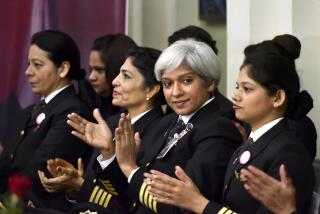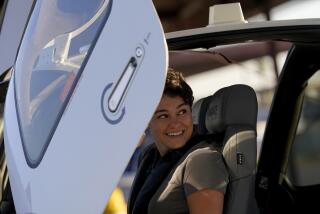Foreign Airlines Solve Their Pilot Shortage With Schools--in the U.S. : Aviation: JAL trains students in California’s wine country, All Nippon in Bakersfield. Air France, Lufthansa, Iberia, Swiss Air, China Air and Gulf Air all send their pilots to America to learn to fly.
- Share via
NAPA, Calif. — It would seem to be the model of a Japanese flight school.
Young, uniformed cadets study with quiet earnestness in classrooms with posters of samurai and geishas exhorting diligence. Instructors are greeted with bows; students stand at attention on the flight line to show respect when one of their own takes off.
But although the student body is entirely Japanese, the school is American.
Run by a U.S. firm called IASCO, this academy in the heart of California’s wine country prepares pilots for 30-year flying careers with Japan Air Lines.
“When they graduate from here, they can go directly to the second seat of a 747,” said Ed Hill, the manager of the $9-million complex set among the flat fields of the valley. “In most flight schools, they try to get you through in a mimimum amount of time. It’s much more structured here.”
There is irony in the fact that JAL and other foreign carriers school their pilots in the United States; the United States is facing a projected pilot shortage of its own.
As nearly one-third of U.S. pilots reach the mandatory retirement age of 60 over the next decade, this country’s airlines face a projected drop in the number of experienced pilots. With their longtime source--the military--training fewer pilots, airlines are relying on the open market to fill the gap.
The dozens of flight schools and aeronautic colleges in the nation provide the training for the estimated 14,000 people who receive commercial pilots’ licenses annually. A certain percentage go on to work long hours for short pay as commuter airline pilots, hoping the sacrifice will someday earn them a six-figure salary with a major airline.
But there are pitfalls in the journey from tiny student Cessna to jumbo jet. Without the rigorous selection and training done by the military, the airlines must cull pilots from many different training grounds and experience.
“Civilians come through a multitude of companies. It makes for more work to check them out,” said Louis Smith, president of FAPA, an Atlanta-based firm that offers career and financial counseling to aviation professionals. “That’s why the military is so desirable. Their pilots are known entities.”
The Air Line Pilot’s Assn. has expressed concern about the array of training paths, from college aviation programs to individual flight instruction.
“Some will have received better training than others. What we’ll have is not a standard-issue airline pilot,” said Bob Pastore, a TWA captain and chairman of ALPA’s Pilot Training Review Task Force.
Many foreign airlines don’t face that problem. They provide all the training, usually hiring people with little or no flight experience to become pilots. When the training is finished, the pilots are a known commodity.
Carriers like JAL take this route by necessity. With little private aviation, limited air space and only a small military supply to draw from, intensive, full-time training schools in this country are the only option.
JAL has been training pilots in Napa for 20 years. All Nippon has a school in Bakersfield. Air France, Lufthansa and Iberia student pilots have trained in Phoenix, and Swiss Air at Vero Beach, Fla. The University of North Dakota teaches pilots for China Air and Gulf Air.
Almost all these programs use the ab anitio approach, Latin for “from the beginning.” And these courses are just that: Students are recent college graduates with little or no flight experience.
Keiji Kushino, a 26-year-old engineering graduate, was never much interested in flying until recruited by JAL. Now, in first-officer ground school back in Japan, he looks on it as a secure, lifetime job.
“Everything is a first experience,” he said. “It is very exciting.”
Kushino and his fellow students were hired after detailed physical and psychological testing to determine if they would make good pilots and fit the cockpit culture at JAL.
The salaries the students are paid during their more than 3 1/2 years of schooling represent a long-term investment by JAL. In return, the airline gets a pilot, trained to specification, who likely will stay with the company for 30 years or more.
“These students are molded into what JAL wants,” said Hill, the IASCO complex manager. “Very few American airlines are involved in training like this.”
That’s because U.S. carriers haven’t had to be. World War II and the Cold War supplied a steady stream of military-trained pilots. With more than enough university and flight schools available for those willing to pay, airlines are understandably reluctant to commit to the estimated $1 million JAL spends to train each pilot.
“There is a tremendous infrastructure out there for the airlines,” said Smith, the FAPA president. “Why should they spend the money?”
The answer, say people like Hill, comes in the standardized, concentrated training.
The JAL course is similar to military flight school. Cadets fly nearly every day in high-performance trainers painted in JAL red and white, with the silhouette of a stork on the rudder.
“These are not casual students. They fly day and night,” said Ed Dove, an instructor at the school. “I would have loved to have gone through this.”
The training begins before the students come to Napa. The first nine months are spent in Tokyo on corporate orientation and ground school. The students then travel to California for a nine-month stint of flight training, flying four days a week.
Classes of a dozen students each then go back to Japan for three months of multi-engine and instrument ground school before returning to Napa for another three months of classroom instruction and concentrated flying.
Specialized courses are added: lessons in flying a multi-crew aircraft, flight safety, human factors, cockpit management.
The final nine months are spent at a converted military base at Roswell, N.M., where the young first officers practice in a Boeing 747.
When they receive their diplomas, the JAL students will have about 400 flight hours and be considered ready to take the second seat of a jumbo jet.
FAA regulations require 235 hours for a commercial pilot’s license. But in the past, most U.S. airlines wouldn’t touch a pilot with less than a few thousand hours.
That is changing. With wholesale retirements of current U.S. pilots, the level of experience among new hires is dropping. Some airlines have even come to Napa to study the JAL academy.
More to Read
Inside the business of entertainment
The Wide Shot brings you news, analysis and insights on everything from streaming wars to production — and what it all means for the future.
You may occasionally receive promotional content from the Los Angeles Times.









